Characterization of Low-Symmetry Structures from Phase Equilibrium of Fe-Al System—Microstructures and Mechanical Properties
Abstract
:1. Introduction
2. Results and Discussion
2.1. Structural Studies
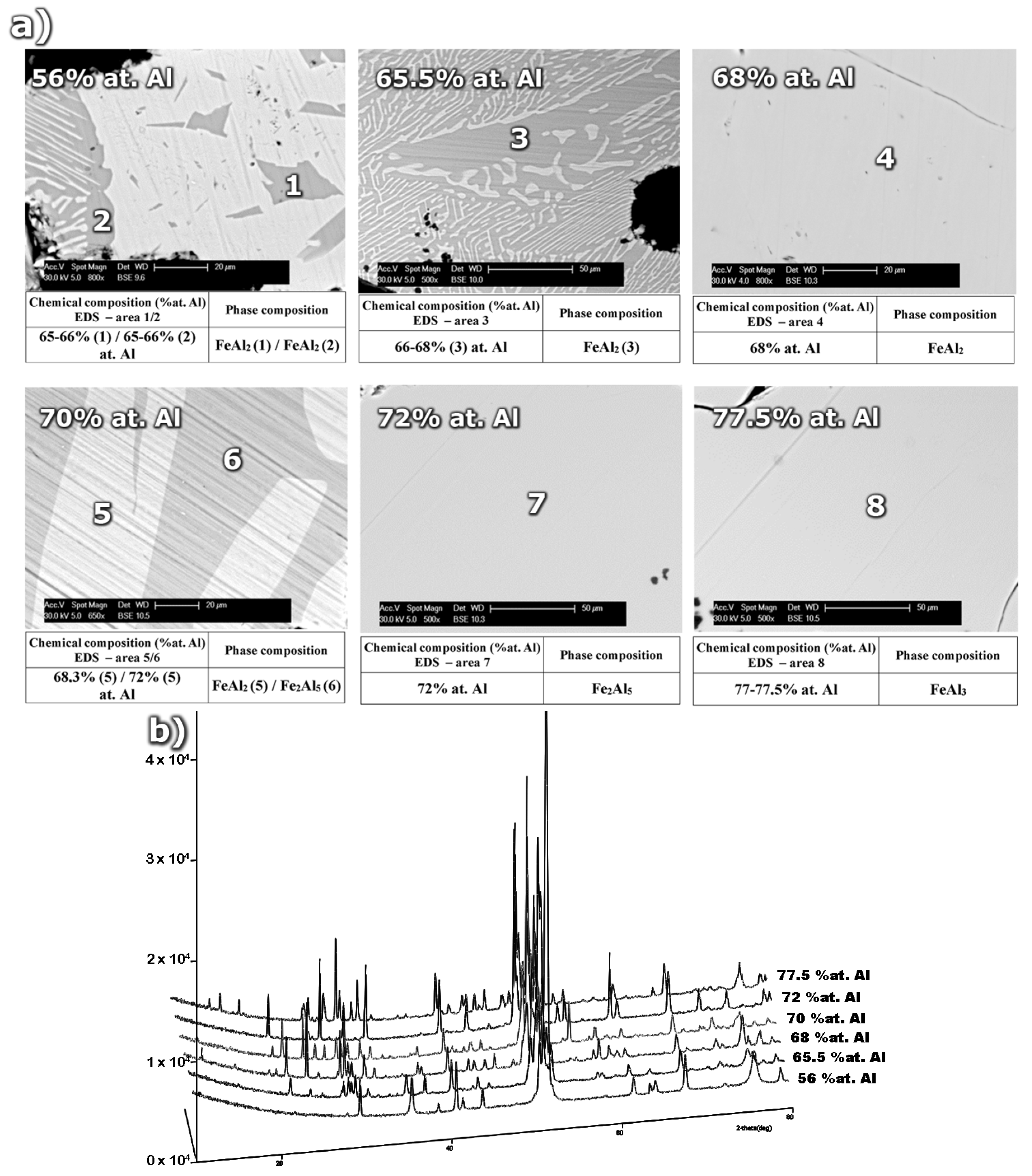
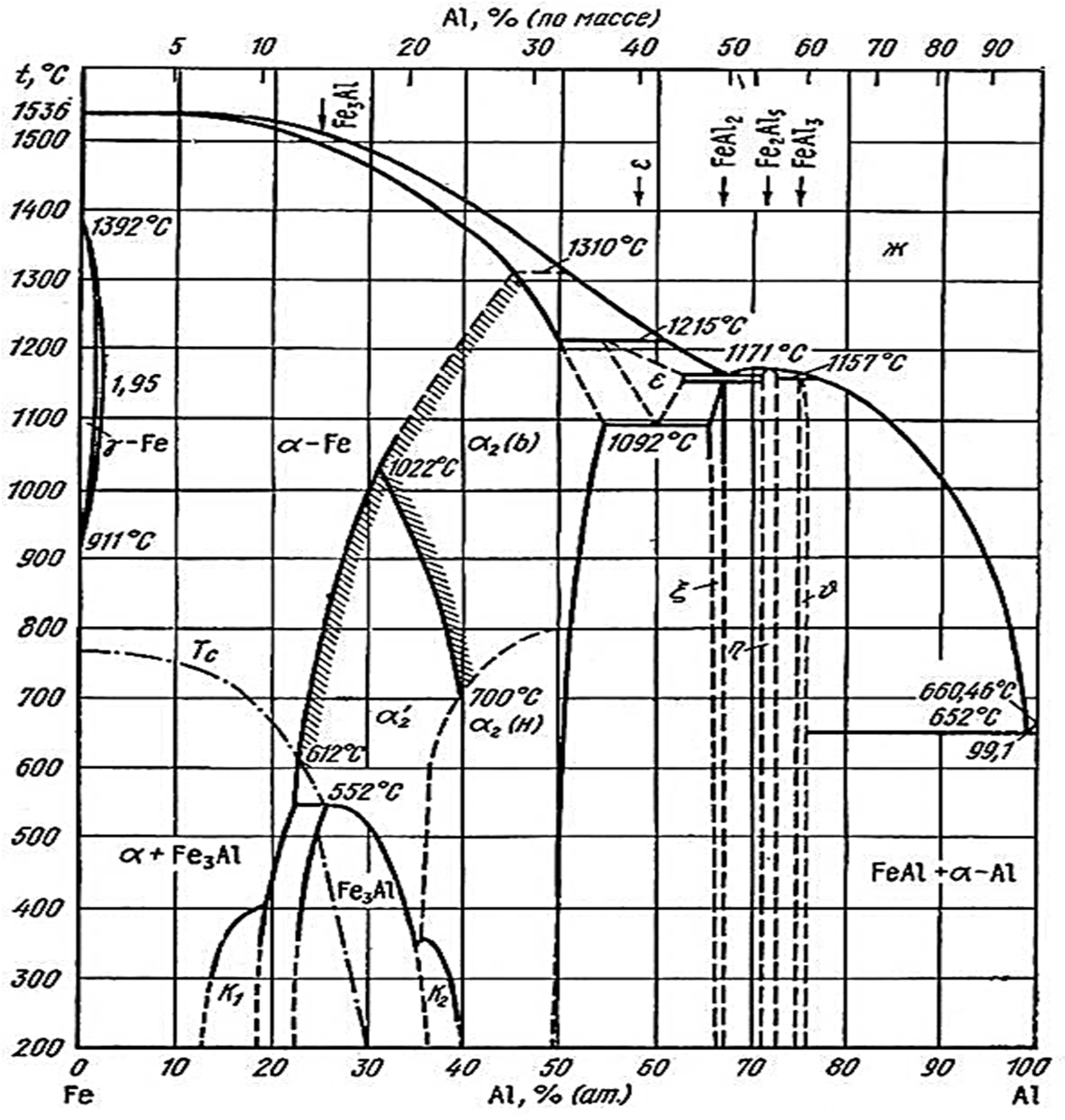
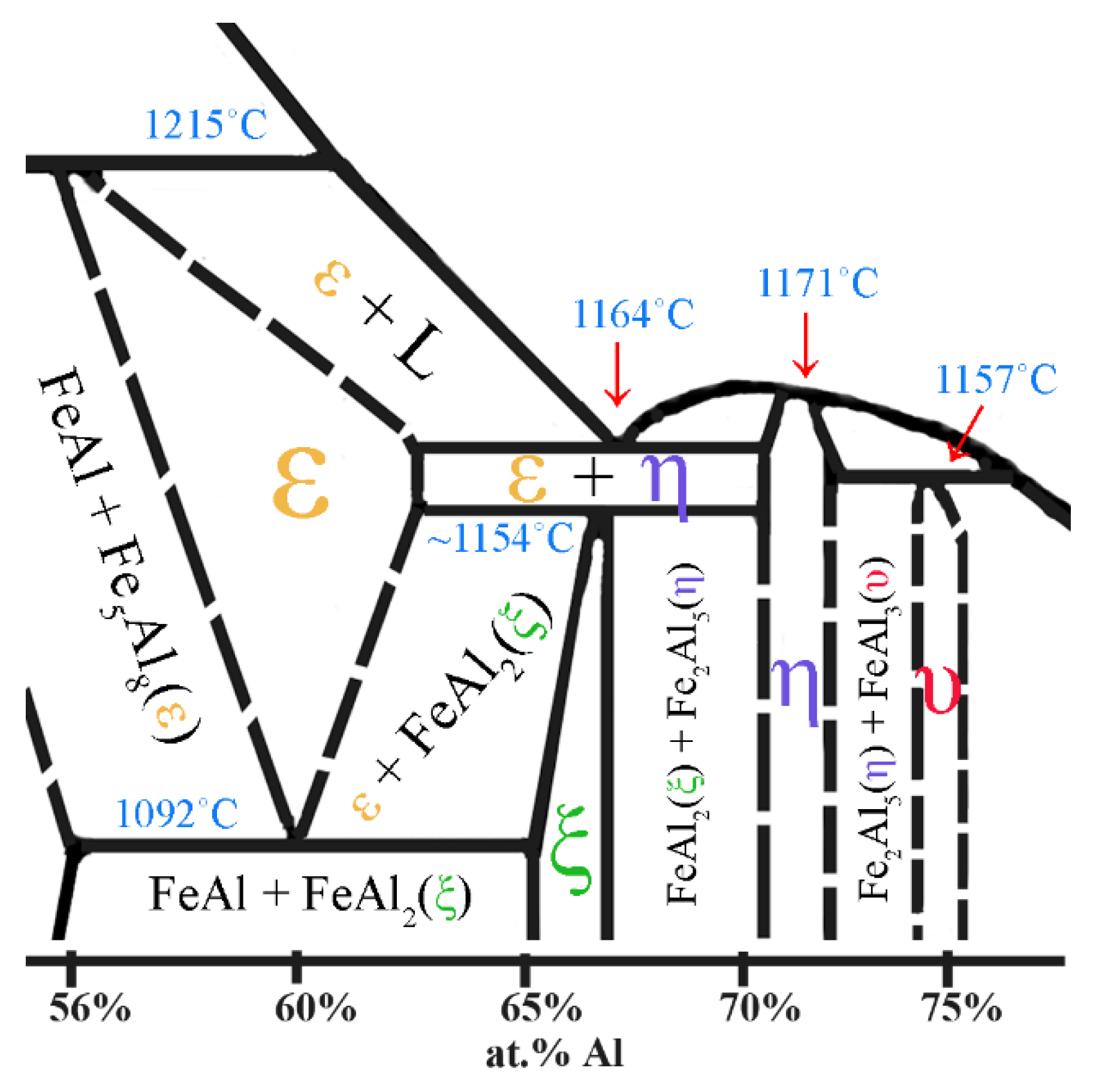
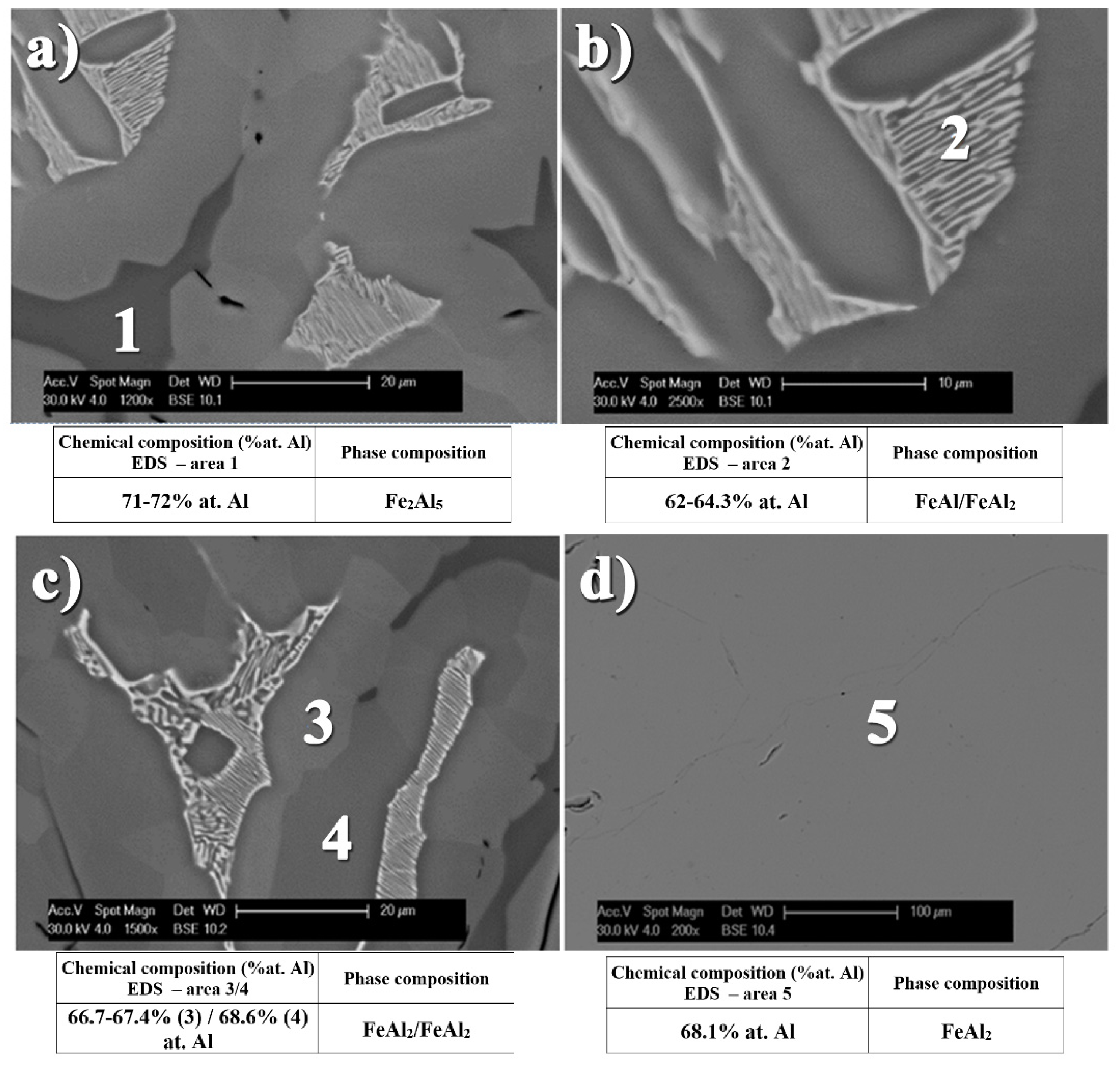

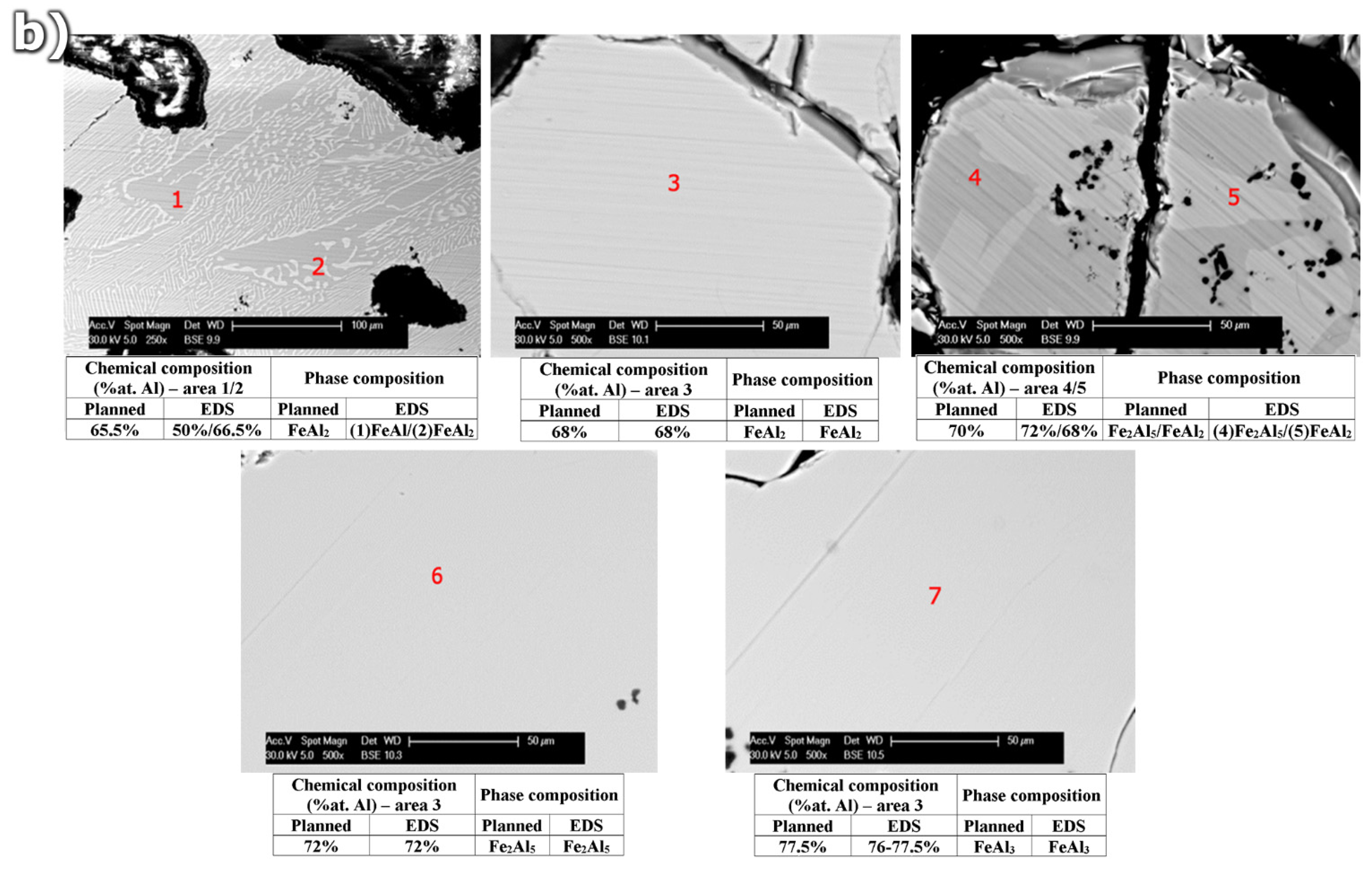

2.2. Mechanical Properties Test
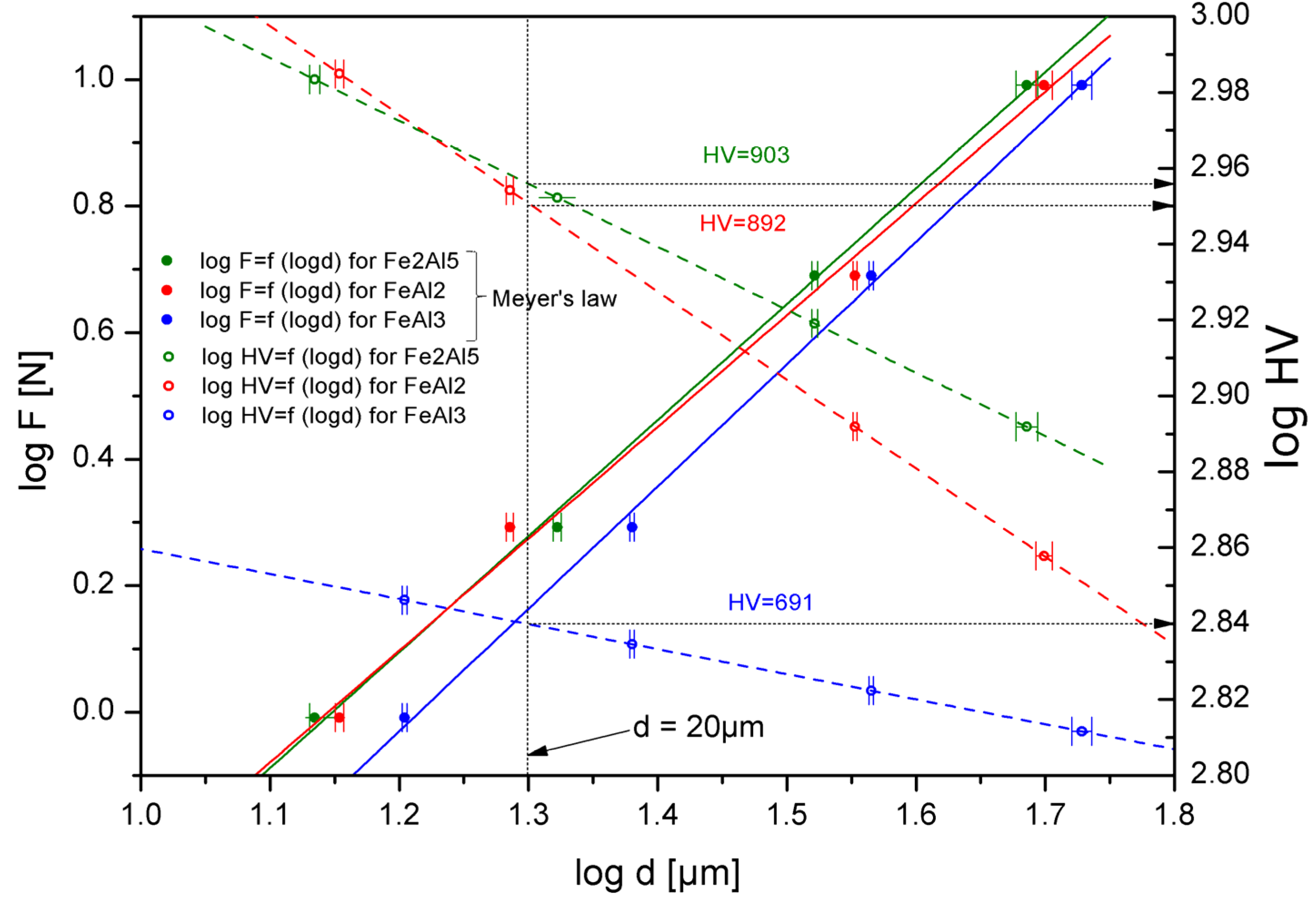
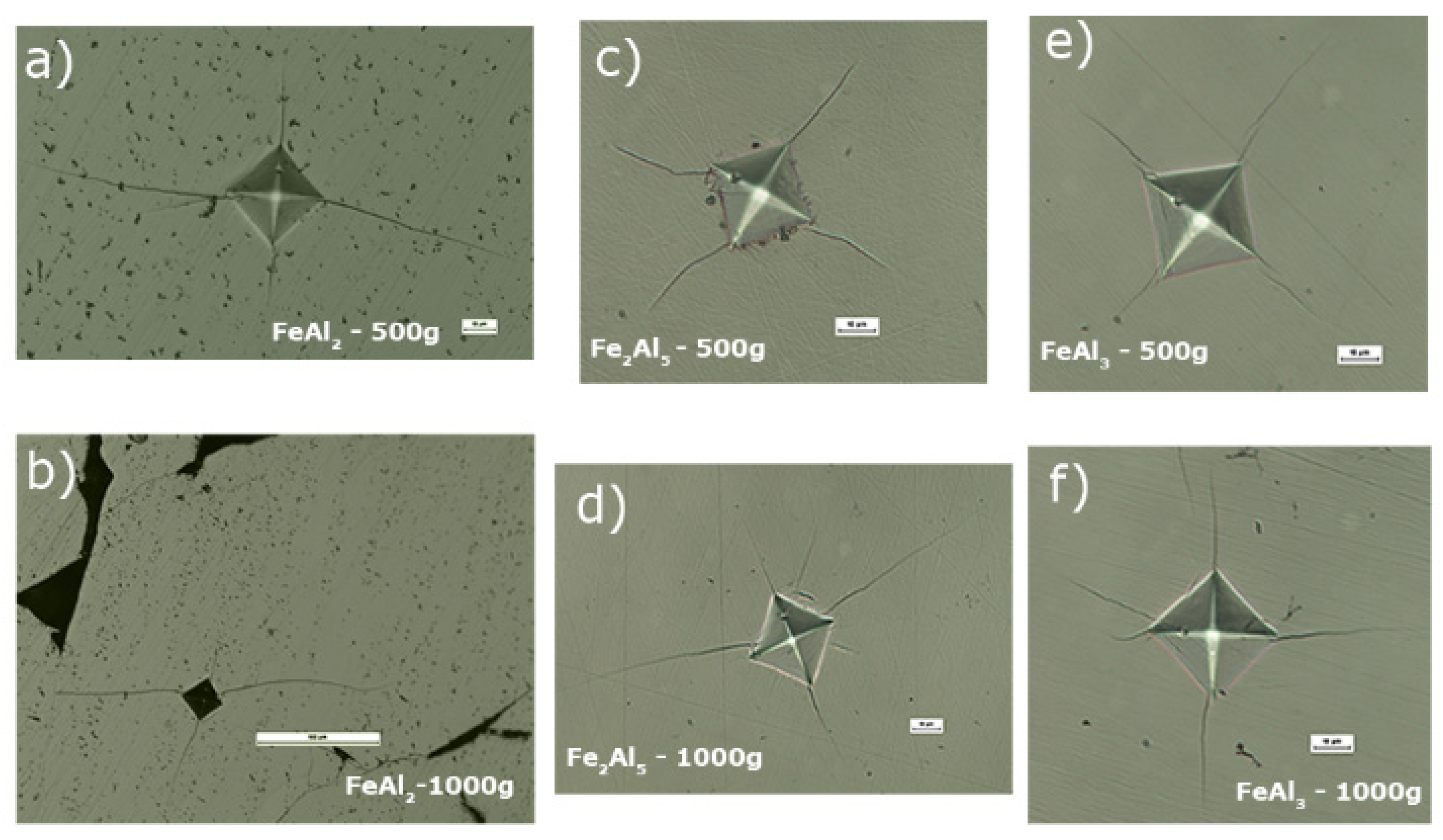

2.3. Discussion
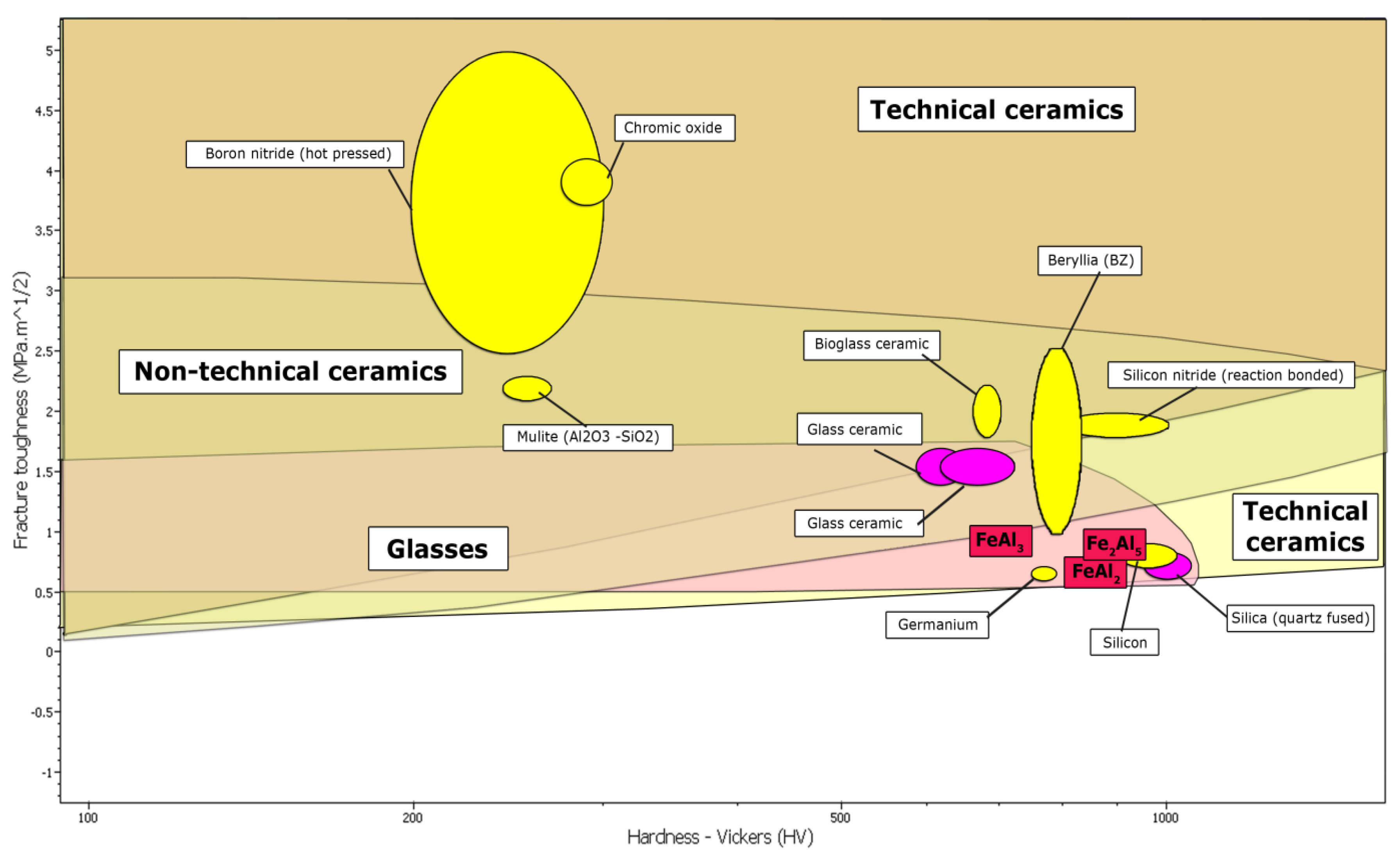
| Material/Properties | HV [GPa] | E [GPa] | V [-] | K1C [MPa/m0.5] | Ib [μm−0.5] | P* [N] | b [μm] | ref. |
|---|---|---|---|---|---|---|---|---|
| Diament | 81 | 1000–1200 | 0.07–0.2 | 5.3 | 15.00 | 0.02 | - | [49,54,55] |
| Al2O3 | 14–18 | 360–420 | 0.22–0.25 | 3–5 | 4.00 | 1.0 | - | [49,54,55] |
| SiC | 18–25 | 340–450 | 0.18–0.19 | 3 | 7.20 | 0.13 | - | [49,54,55] |
| Steel | 1.6–5.0 | 190–210 | 0.240–0.300 | 50–210 | 0.014 | 0.1 × 109 | - | [49,54,55] |
| Cu | 0.1–0.8 | 100–124 | 0.310–0.340 | 100 | 0.008 | 3 × 109 | - | [49,54,55] |
| Al | 0.1–0.4 | 69–71 | 0.260–0.360 | 350 | 0.001 | 4 × 1012 | - | [49,54,55] |
| WC-Co | 12–20 | 540–610 | 0.280–0.300 | 7–28 | 1.10 | 170 | - | [54,58] |
| NiAl | 2.7–5.3 | 100–310 | 0.23–0.45 | 4–6 | 0.50 | 110 | - | [58,59,60] |
| Ni3Al | 3.5–4.5 | 100–300 | 0.2–0.35 | 30–40 | 0.10 | 14 × 104 | - | [61,62] |
| Fe3Al | 2.5–3.5 | 150 | 0.290–0.400 | 25–35 | 0.12 | 30 × 104 | - | [50,51,52,53] |
| FeAl | 4–5.2 | 260 | 0.300–0.310 | 8–15 | 2.88 | 2875 | - | [50,51,52,53,54,55,56,57] |
| FeAl2 | 9–10.5 | 475 | 0.300 | 3.88 | 2.71 | 4 | 81 | [this study] |
| Fe2Al5 | 9.5–11 | 284 | 0.300 | 5.17 | 2.13 | 9 | 62 | [this study] |
| FeAl3 | 8–9.8 | 328 | 0.300 | 4.92 | 1.99 | 13 | 75 | [this study] |
3. Experimental Section
4. Conclusions
Acknowledgments
Author Contributions
Conflicts of Interest
References
- Gu, J.; Gu, S.; Xue, L.; Wu, S.; Yan, Y. Microstructure and mechanical properties of in situ Al13Fe4/Al composites prepared by mechanical alloying and spark plasma sintering. Mater. Sci. Eng. 2012, 558, 684–691. [Google Scholar] [CrossRef]
- Iizadi, S.; Akbaria, G.H.; Janghorba, K. Sintering and mechanical properties of mechanically alloyed Fe-Al-(B) nanostructures. J. Alloys Compd. 2010, 496, 699–702. [Google Scholar] [CrossRef]
- D’Angelo, L.; D’Onofrio, L.; Gonzalez, G. Nanophase intermetallic FeAl obtained by sintering after mechanical alloying. J. Alloys Compd. 2009, 483, 154–158. [Google Scholar] [CrossRef]
- Jóźwiak, S.; Karczewski, K. Influence of aluminum oxides on abrasive wear resistance of Fe-50 at% Al intermetallic sinters. J. Alloys Compd. 2009, 482, 405–411. [Google Scholar] [CrossRef]
- Novák, P.; Knotek, V.; Voděrová, M.; Kubásek, J.; Šerák, J.; Michalcová, A.; Vojtěch, D. Intermediary phases formation in Fe-Al-Si alloys during reactive sintering. J. Alloys Compd. 2010, 497, 90–94. [Google Scholar] [CrossRef]
- Matysik, P.; Jozwiak, S.; Czujko, T. The kinetics of non-isothermal iron and aluminum powder mixtures sintering in protective atmosphere. J. Alloys Compd. 2013, 549, 92–99. [Google Scholar] [CrossRef]
- Novák, P.; Michalcová, A.; Marek, I.; Mudrová, M.; Saksl, K.; Bednarcík, J.; Zikmund, P.; Vojtěch, D. On the formation of intermetallics in Fe-Al system—An in situ XRD study. Intermetallics 2013, 32, 127–136. [Google Scholar] [CrossRef]
- Pocheć, E.; Jóźwiak, S.; Karczewski, K.; Bojar, Z. Fe-Al phase formation around SHS reactions under isothermal conditions. J. Alloys Compd. 2011, 509, 1124–1128. [Google Scholar] [CrossRef]
- Nicula, R.; Turquier, F.; Stir, M.; Kodash, V.Y.; Groza, J.R.; Burkel, E. Quasicrystal phase formation in Al-Cu-Fe nanopowders during field-activated sintering (FAST). J. Alloys Compd. 2007, 434–435, 319–323. [Google Scholar]
- Krasnowski, M.; Kulik, T. Bulk amorphous and nanocrystalline Al83Fe17 alloys prepared by consolidation of mechanically alloyed amorphous powder. J. Alloys Compd. 2010, 495, 382–385. [Google Scholar] [CrossRef]
- Durejko, T.; Lipiński, S.; Bojar, Z.; Bystrzycki, J. Processing and characterization of graded metal/intermetallic materials: The example of Fe/FeAl intermetallics. Mater. Des. 2011, 32, 2827–2834. [Google Scholar] [CrossRef]
- Senderowski, C.; Bojar, Z.; Wołczyński, W.; Pawłowski, A. Microstructure characterization of D-gun sprayed Fe-Al intermetallic coatings. Intermetallics 2009, 18, 1405–1409. [Google Scholar] [CrossRef]
- Senderowski, C.; Bojar, Z.; Wołczyński, W.; Roy, G.; Czujko, T. Residual stresses determined by the modified Sachs method within a gas detonation sprayed coatings of the Fe-Al intermetallic. Arch. Metall. Mater. 2007, 52, 569–578. [Google Scholar]
- Wang, L.; Yan, D.; Dong, Y.; Zhang, J.; Chen, X. Nanostructured ceramic composite coating prepared by reactive plasma spraying micro-sized Al-Fe2O3 composite powders. Ceram. Int. 2013, 39, 2437–2442. [Google Scholar] [CrossRef]
- Kubaschewski, O.; Dench, W.A. The heats of formation in the systems titanium-aluminium and titanium-iron. Acta Metall. 1955, 3, 339–346. [Google Scholar] [CrossRef]
- Kattner, U.R.; Burton, B.P. Al-Fe (Aluminum-Iron). In Phase Diagrams of Binary Alloys; Okamoto, H., Ed.; ASM International: Material Park, OH, USA, 1993; pp. 12–28. [Google Scholar]
- Massalski, T.B. Binary Alloy Phase Diagrams, 2nd ed.; ASM International: Material Park, OH, USA, 1990; pp. 3401–3441. [Google Scholar]
- Palm, M. Concepts derived from phase diagram studies for the strengthening of Fe-Al-based alloys. Intermetallics 2005, 13, 1286–1295. [Google Scholar] [CrossRef]
- Диаграммы Состояния—Phase Diagrams. Available online: http://steelcast.ru/equilibrium_diagram (accessed on 25 January 2014). (In Russian)
- Ellner, M. Polymorphic phase transformation of Fe4Al13 causing multiple twinning with decagonal pseudo-symmetry. Acta Cryst. 1995, B51, 31–36. [Google Scholar] [CrossRef]
- Stein, F.; Vogel, S.C.; Eumann, M.; Palm, M. Determination of the crystal structure of the ɛ phase in the Fe-Al system by high-temperature neutron diffraction. Intermetallics 2010, 18, 150–156. [Google Scholar] [CrossRef]
- Sundman, B.; Ohnuma, I.; Dupin, N.; Kattner, U.R.; Fries, S.G. An assessment of the entire Al-Fe system including D03 ordering. Acta Mater. 2009, 57, 2896–2908. [Google Scholar] [CrossRef]
- Phan, A.T.; Paek, M.K.; Kang, Y.B. Phase equilibria and thermodynamics of the Fe-Al-C system: Criticalevaluation, experiment and thermodynamic optimization. Acta Mater. 2014, 79, 1–15. [Google Scholar] [CrossRef]
- Chi, J.; Li, Y.; Vagizov, F.G.; Goruganti, V.; Ross, J.H., Jr. NMR and Mössbauer study of spin-glass behavior in FeAl2. Phys. Rev. B 2005, 71. [Google Scholar] [CrossRef]
- Ozaki, H.; Kutsuna, M.; Nakagawa, S.; Miyamoto, K. Laser roll welding of dissimilar metal joint of zinc coated steel to aluminum alloy. J. Laser Appl. 2010, 22, 1–6. [Google Scholar] [CrossRef]
- Rathod, M.J.; Katsuna, M. Joining of aluminum alloy 5052 and low-carbon steel by laser roll welding. Weld. J. 2004, 2, 16–26. [Google Scholar]
- Potesser, M.; Schoeberl, T.; Antrekowitsch, H.; Bruckner, J. The characterization of the intermetallic Fe-Al layer of steel-aluminum weldings. In EPD Congress 2006; The Minerals, Metals & Materials Society: San Antonio, TX, USA, 2006. [Google Scholar]
- Shishkovsky, I.; Missemer, F.; Kakovkina, N.; Smurov, I. Intermetallics synthesis in the Fe-Al system via layer by layer 3D laser cladding. Crystals 2013, 3, 517–529. [Google Scholar] [CrossRef]
- Yousaf, M.; Iqbal, J.; Ajmal, M. Variables affecting growth and morphology of the intermetallic layer (Fe2Al5). Mater. Characteriation 2011, 62, 517–525. [Google Scholar] [CrossRef]
- Pluta, Z.; Hryniewicz, T. Quantitative determination of material hardness. J. Quantum Inf. Sci. 2011, 1, 127–134. [Google Scholar] [CrossRef]
- Lue, C.S.; Oner, Y.; Naugle, D.G.; Ross, J.H., Jr. Spin glass behavior in FeAl2. Phys. Rev. B 2001, 63. [Google Scholar] [CrossRef]
- Shahverdi, H.R.; Ghomashchi, M.R.; Shabestari, S.; Hejazi, J. Microstructural analysis of interfacial reaction between molten aluminium and solid iron. J. Mater. Process. Technol. 2002, 124, 345–352. [Google Scholar] [CrossRef]
- Wang, D. Phase evolution of an aluminized steel by oxidation treatment. Appl. Surf. Sci. 2008, 254, 3026–3032. [Google Scholar] [CrossRef]
- Shiue, R.K.; Wu, S.K.; Lee, Y.L. Transient microstructure evolution of infrared brazed Fe3Al intermetallics using aluminium foil. Intermetallics 2005, 13, 818–826. [Google Scholar] [CrossRef]
- Karczewski, K.; Józwiak, S.; Chojnacki, M.; Bojar, Z. The influence of different additives on the kinetics of self-propagating high-temperature synthesis during the sintering process of Fe and Al elemental powders. Intermetallics 2010, 18, 1401–1404. [Google Scholar] [CrossRef]
- Shen, P.Z.; He, Y.H.; Gao, H.Y.; Zou, J.; Xu, N.P.; Jiang, Y.; Huang, B.Y.; Liu, C.T. Development of a new graded-porosity FeAl alloy by elemental reactive synthesis. Desalination 2009, 249, 29–33. [Google Scholar] [CrossRef]
- Joslin, D.L.; Easton, D.S.; Liu, C.T.; Davis, S.A. Reaction synthesis of Fe-Al alloys. Mater. Sci. Eng. 1995, A192/193, 544–548. [Google Scholar]
- Gedevanishvili, S.; Deevi, S.C. Processing of iron aluminides by pressureless sintering through Fe + Al elemental route. Mater. Sci. Eng. 2002, A325, 163–176. [Google Scholar] [CrossRef]
- Hirose, S.; Itoh, T.; Makita, M.; Fujii, S.; Arai, S.; Sasaki, K.; Saka, H. Defect structure of deformed Fe2Al5 intermetallic compound. Intermetallics 2003, 11, 633–642. [Google Scholar] [CrossRef]
- Gąsior, W.; Dębski, A.; Moser, Z. Formation enthalpy of intermetallic phases from Al-Fe system measured with solution calorimetric method. Intermetallics 2012, 24, 99–105. [Google Scholar] [CrossRef]
- Bastin, G.F.; van Loo, F.J.J.; Vrolijk, J.W.G.A.; Wolff, L.R. Crystallography of aligned Fe-Al eutectoid. J. Crystal Growth 1978, 43, 745–751. [Google Scholar] [CrossRef]
- Corby, R.N.; Black, P.J. Structure of FeAl2 by anomalous dispersion methods. Acta Crystallogr. 1973, 29, 2669–2677. [Google Scholar] [CrossRef]
- Grin, J.; Burkhardt, U.; Ellner, M.; Peters, K. Refinement of the Fe4Al13 Structure and its relationship to quasihomological homotypical structures. Z. Kristallogr. 1994, 209, 479–487. [Google Scholar] [CrossRef]
- Popčević, P.; Smontara, A.; Ivkov, J.; Wencka, M.; Komelj, M.; Jeglič, P.; Vrtnik, S.; Bobnar, M.; Jagličić, Z.; Bauerr, B.; et al. Anisotropic physical properties of the Al13Fe4 complex intermetallic and its ternary derivative Al13(Fe,Ni)4. Phys. Rev. B 2010, 81. [Google Scholar] [CrossRef]
- Schubert, K.; Kluge, M. Über den Bindungszustand bei Fe2Al5 und MnAl6. Zeitschrift Naturforschung Teil A 1953, 8, 755–776. [Google Scholar]
- Chi, J. A Nuclear Magnetic Resonance Probe of Fe-Al and Al20V2Eu Intermetallics. Ph.D. Thesis, University of Science and Technology of China, Anhui, China, August 2007. [Google Scholar]
- Song, Y.K.; Varin, R.A. Indentation microcracking and toughness of newly discovered ternary intermetallic phases in the Ni-Si-Mg system. Intermetallics 1998, 6, 379–393. [Google Scholar] [CrossRef]
- Shetty, D.K.; Wright, I.G.; Mincer, P.N.; Clauer, A.M. Indentation fracture of WC-Co cermets. J. Mater. Sci. 1985, 20, 1873–1882. [Google Scholar] [CrossRef]
- Standard Test Method for Knoop and Vickers Hardness of Materials; ASTM E384-11e1; ASTM International: West Conshohocken, PA, USA, 2011.
- Hausild, P.; Karlik, M.; Siegl, J.; Nedbal, I. Fractographic analysis of the crack growth in the Fe3Al based intermetallic alloy. Intermetallics 2005, 13, 217–225. [Google Scholar] [CrossRef]
- Niu, X.; Wang, L. Effect of transition-metal substitution on electronic and mechanical properties of Fe3Al: First-principles calculations. Comput. Mater. Sci. 2012, 53, 128–132. [Google Scholar] [CrossRef]
- Qiu, R.; Iwamoto, C.; Satonaka, S. Interfacial microstructure and strength of steel/aluminum alloy joints welded by resistance spot welding with cover plate. J. Mater. Process. Technol. 2009, 209, 4186–4193. [Google Scholar] [CrossRef]
- Wang, J.; Xing, J.; Qiu, Z.; Zhi, X.; Cao, L. Effect of fabrication methods on microstructure and mechanical properties of Fe3Al-based alloys. J. Alloys Compd. 2009, 488, 117–122. [Google Scholar] [CrossRef]
- Moradkhani, A.; Baharvandi, H.; Tajdari, M.; Latifi, H.; Martikainen, J. Determination of fracture toughness using the area of micro-crack tracks left in brittle materials by Vickers indentation test. J. Adv. Ceram. 2013, 2, 87–102. [Google Scholar] [CrossRef]
- Rocha-Rangel, E.; Refugio-Garcíab, E.; Miranda-Hernández, J.G.; Terrés-Rojas, E. Fracture toughness enhancement for metal-reinforced alumina. J. Ceram. Process. Res. 2009, 10, 744–747. [Google Scholar]
- Miao, Y.; Han, D.; Xu, X.; Wu, B. Phase constitution in the interfacial region of laser penetration brazed magnesium-steel joints. Mater. Character. 2014, 93, 87–93. [Google Scholar] [CrossRef]
- Tang, N.; Li, Y.P.; Kurosu, S.; Koizumi, Y.; Matsumoto, H.; Chiba, A. Interfacial reactions of solid Co and solid Fe with liquid Al. Corros. Sci. 2012, 60, 32–37. [Google Scholar] [CrossRef]
- Bolelli, G.; Cannillo, V.; Lusvarghi, L.; Rosa, R.; Valarezo, A.; Choi, W.B.; Dey, R.; Weyant, C.; Sampath, S. Functionally graded WC-Co/NiAl HVOF coatings for damage tolerance, wear and corrosion protection. Surf. Coat. Technol. 2012, 206, 2585–2601. [Google Scholar] [CrossRef]
- Fu, H.; Li, X.; Liu, W.; Ma, Y.; Gao, T.; Hong, X. Electronic and dynamical properties of NiAl studied from first principles. Intermetallics 2011, 19, 1959–1967. [Google Scholar] [CrossRef]
- Wang, Y.; Wang, Z.; Yang, Y.; Chen, W. The effects of ceria on the mechanical properties and thermal shock resistance of thermal sprayed NiAl intermetallic coatings. Intermetallics 2008, 16, 682–688. [Google Scholar] [CrossRef]
- Wu, Q.; Li, S. Alloying element additions to Ni3Al: Site preferences and effects on elastic properties from first-principles calculations. Comput. Mater. Sci. 2012, 53, 436–443. [Google Scholar] [CrossRef]
- Ozdemir, O.; Zeytin, S.; Bindal, C. Tribological properties of Ni3Al produced by pressure-assisted volume combustion synthesis. Tribol. Int. 2012, 53, 22–27. [Google Scholar] [CrossRef]
© 2015 by the authors; licensee MDPI, Basel, Switzerland. This article is an open access article distributed under the terms and conditions of the Creative Commons Attribution license (http://creativecommons.org/licenses/by/4.0/).
Share and Cite
Matysik, P.; Jóźwiak, S.; Czujko, T. Characterization of Low-Symmetry Structures from Phase Equilibrium of Fe-Al System—Microstructures and Mechanical Properties. Materials 2015, 8, 914-931. https://doi.org/10.3390/ma8030914
Matysik P, Jóźwiak S, Czujko T. Characterization of Low-Symmetry Structures from Phase Equilibrium of Fe-Al System—Microstructures and Mechanical Properties. Materials. 2015; 8(3):914-931. https://doi.org/10.3390/ma8030914
Chicago/Turabian StyleMatysik, Piotr, Stanisław Jóźwiak, and Tomasz Czujko. 2015. "Characterization of Low-Symmetry Structures from Phase Equilibrium of Fe-Al System—Microstructures and Mechanical Properties" Materials 8, no. 3: 914-931. https://doi.org/10.3390/ma8030914
APA StyleMatysik, P., Jóźwiak, S., & Czujko, T. (2015). Characterization of Low-Symmetry Structures from Phase Equilibrium of Fe-Al System—Microstructures and Mechanical Properties. Materials, 8(3), 914-931. https://doi.org/10.3390/ma8030914







